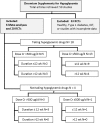Chromium supplements for glycemic control in type 2 diabetes: limited evidence of effectiveness
- PMID: 27261273
- PMCID: PMC5009459
- DOI: 10.1093/nutrit/nuw011
Chromium supplements for glycemic control in type 2 diabetes: limited evidence of effectiveness
Abstract
Some adults with type 2 diabetes mellitus (T2DM) believe that chromium-containing supplements will help control their disease, but the evidence is mixed. This narrative review examines the efficacy of chromium supplements for improving glycemic control as measured by decreases in fasting plasma glucose (FPG) or hemoglobin A1c (HbA1c). Using systematic search criteria, 20 randomized controlled trials of chromium supplementation in T2DM patients were identified. Clinically meaningful treatment goals were defined as an FPG of ≤7.2 mmol/dL, a decline in HbA1c to ≤7%, or a decrease of ≥0.5% in HbA1c. In only a few randomized controlled trials did FPG (5 of 20), HbA1c (3 of 14), or both (1 of 14) reach the treatment goals with chromium supplementation. HbA1c declined by ≥0.5% in 5 of 14 studies. On the basis of the low strength of existing evidence, chromium supplements have limited effectiveness, and there is little rationale to recommend their use for glycemic control in patients with existing T2DM. Future meta-analyses should include only high-quality studies with similar forms of chromium and comparable inclusion/exclusion criteria to provide scientifically sound recommendations for clinicians.
Keywords: chromium; fasting plasma glucose; hemoglobin A1c; type 2 diabetes mellitus..
Published by Oxford University Press on behalf of the International Life Sciences Institute 2016. This work is written by US Government employees and is in the public domain in the United States.
Figures





Similar articles
-
Do Cinnamon Supplements Have a Role in Glycemic Control in Type 2 Diabetes? A Narrative Review.J Acad Nutr Diet. 2016 Nov;116(11):1794-1802. doi: 10.1016/j.jand.2016.07.015. Epub 2016 Sep 8. J Acad Nutr Diet. 2016. PMID: 27618575 Free PMC article. Review.
-
Effect of Chromium Supplementation on Blood Glucose and Lipid Levels in Patients with Type 2 Diabetes Mellitus: a Systematic Review and Meta-analysis.Biol Trace Elem Res. 2022 Feb;200(2):516-525. doi: 10.1007/s12011-021-02693-3. Epub 2021 Mar 30. Biol Trace Elem Res. 2022. PMID: 33783683 Review.
-
Effects of chromium supplementation on glycemic control in patients with type 2 diabetes: a systematic review and meta-analysis of randomized controlled trials.Pharmacol Res. 2020 Nov;161:105098. doi: 10.1016/j.phrs.2020.105098. Epub 2020 Jul 28. Pharmacol Res. 2020. PMID: 32730903
-
Effect of chromium supplementation on glycated hemoglobin and fasting plasma glucose in patients with diabetes mellitus.Nutr J. 2015 Feb 13;14:14. doi: 10.1186/1475-2891-14-14. Nutr J. 2015. PMID: 25971249 Free PMC article. Review.
-
Systematic review and meta-analysis of the efficacy and safety of chromium supplementation in diabetes.J Clin Pharm Ther. 2014 Jun;39(3):292-306. doi: 10.1111/jcpt.12147. Epub 2014 Mar 17. J Clin Pharm Ther. 2014. PMID: 24635480 Review.
Cited by
-
The Protective Effects of Taurine, a Non-essential Amino Acid, Against Metals Toxicities: A Review Article.Biol Trace Elem Res. 2024 May 13. doi: 10.1007/s12011-024-04191-8. Online ahead of print. Biol Trace Elem Res. 2024. PMID: 38735894 Review.
-
Understanding Cr(III) Action on Mitochondrial ATP Synthase and AMPK Efficacy: Insights from Previous Studies-a Review.Biol Trace Elem Res. 2024 Apr;202(4):1325-1334. doi: 10.1007/s12011-023-04010-6. Epub 2023 Dec 18. Biol Trace Elem Res. 2024. PMID: 38105318 Review.
-
A comparative study to assess the use of chromium in type 2 diabetes mellitus.J Med Life. 2023 Aug;16(8):1178-1182. doi: 10.25122/jml-2023-0081. J Med Life. 2023. PMID: 38024820 Free PMC article. Clinical Trial.
-
Association and Interaction between Heavy Metals and Hyperuricemia in a Taiwanese Population.Diagnostics (Basel). 2023 May 15;13(10):1741. doi: 10.3390/diagnostics13101741. Diagnostics (Basel). 2023. PMID: 37238228 Free PMC article.
-
Non-invasive radionuclide imaging of trace metal trafficking in health and disease: "PET metallomics".RSC Chem Biol. 2022 Apr 11;3(5):495-518. doi: 10.1039/d2cb00033d. eCollection 2022 May 11. RSC Chem Biol. 2022. PMID: 35656481 Free PMC article. Review.
References
-
- American Diabetes Association. Statistics about diabetes– overall numbers, diabetes and prediabetes. http://www.diabetes.org/diabetes-basics/statistics/. Last reviewed May 18, 2015. Accessed June 10, 2015.
-
- Institute of Medicine (US) Panel on Micronutrients. Dietary Reference Intakes for Vitamin A, Vitamin K, Arsenic, Boron, Chromium, Copper, Iodine, Iron, Manganese, Molybdenum, Nickel, Silicon, Vanadium, and Zinc. Washington, DC, USA: National Academies Press; 2001. - PubMed
-
- Bailey RL, Gahche JJ, Miller PE, et al. Why US adults use dietary supplements. JAMA Intern Med. 2013;173:355–361. - PubMed
-
- Vincent JB. The biochemistry of chromium. J Nutr. 2000;130:715–718. - PubMed
-
- Jeejeebhoy KN, Chu RC, Marliss EB, et al. Chromium deficiency, glucose intolerance, and neuropathy reversed by chromium supplementation, in a patient receiving long-term total parenteral nutrition. Am J Clin Nutr. 1977;30:531–538. - PubMed
Publication types
MeSH terms
Substances
LinkOut - more resources
Full Text Sources
Other Literature Sources
Medical


